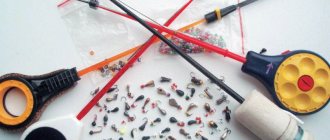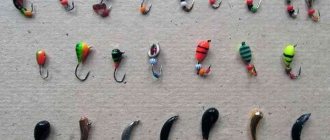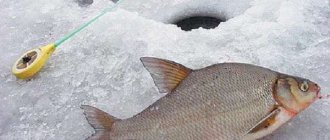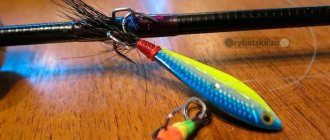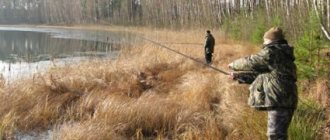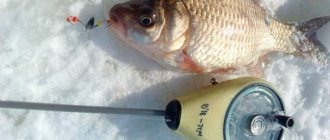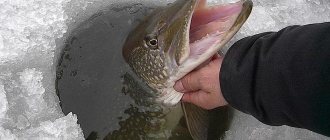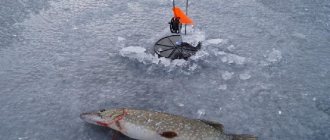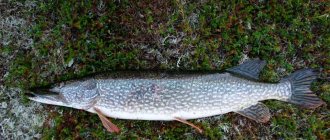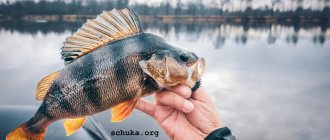The most common fish when fishing on the first ice is roach. She is omnipresent, gluttonous and capricious. The high taste of roach explains its popularity among different categories of fishermen.
A caught roach looks like a silver ingot. The average weight is 0.3−0.5 kg. Found at the boundaries of strong and weak currents. The roach is omnivorous, its main food is insect larvae, mollusks, worms, and aquatic vegetation.
The fisherman needs to know what gear and jigs to use for roach in winter so that this beautiful fish will delight you with its bites.
Tackle for catching roach in winter
Winter fishing is the cheapest to purchase gear; anyone can afford it. The simplest tackle is a winter float rod; it is the basis for all other fishing gear.
Comprises:
- fishing rod - includes a whip and a handle. A whip (rod) 20-30 cm long is inserted into one end of the handle. The handle itself must have a device for installation on ice;
- reels - micro-type reels are used; in winter fishing they only store fishing line;
- fishing line - ordinary fishing line with a thickness of 0.05 to 0.15 mm. Only in the presence of large fish is it increased to 0.18 mm;
- float - light and sensitive, up to 25 mm in size, the upper part is painted red for easy observation of the bite;
- hook N3−3.5 with a particularly sharp sting.
A winter float rod can provide a catch even in the dead of winter, especially if you bait a suitable hole. Hooking the fish is done only by a rod; it is fished with a special fishing line, which is handled by hand.
The second gear for fishing from ice is a nodding rod for fishing with a jig in winter. This fishing rod has a special system - a nod and jigs for winter fishing. The nod is a bite alarm attached to a fishing rod. It is made of plastic, rubber or steel and is up to 10-15 cm long. The nod must retain its functionality in any frost.
Now a few words about the whip
Let's start with the fact that the roach bite is careful and easy; performing a sharp hook, as, for example, when catching pike perch, is not required, so when choosing a whip, it is recommended to focus on soft options. The length is determined depending on the fishing method; for baitless gear, a whip 12 cm long is sufficient. When fishing with bait, the whip should be longer (15-18 cm).
We figured out the gear, now how to equip it correctly. So, there is no need to save on fishing line. As the main one, we use options with a maximum diameter of 0.15 mm; if roach activity is weak, then 0.12 mm. A jig is tied to the base of the fishing line; we’ll discuss the best options below.
In winter gear, every single structural element is important, but despite this, the nod should be taken most seriously. The bite of roach is a little stronger than the bite of winter bream; for the latter, nods up to 25 cm long are selected. How to correctly determine the optimal nod length for catching roach? Only through experiment. It is important that the nod springs easily under the weight of the jig used. We recommend buying plastic sliding nods, the length of which can be easily and quickly adjusted from 3 to 12 cm.
How to choose jigs for roach
The most catchy jigs for roach for winter fishing are:
- pellet - a weight with a soldered hook;
- "bug";
- "triangular";
- "Ural";
- "ant".
Jigs for catching roach in winter are small in size, usually from 3 to 5-7 mm. The coloring is always bright and is designed to attract fish from a distance and are equipped with different baits.
As you know, roaches are especially active on the first ice. Fishermen, in addition to jigs with attachments, also use jigs without attachments, the so-called reelless jigs. Their names speak for themselves:
- “devil” is ordinary;
- "devil" compound;
- "ant";
- "butterfly".
- “goat” - has a double hook;
- “jellyfish” is a small jig with one hook.
Read: Mormyshka devil
To successfully catch fish, you need to understand its diet. The main delicacy is mormysh - an amphipod crustacean. This is where the name of this part of the winter fishing gear comes from. In summer it is found on plants, and in winter, due to lack of oxygen, it attaches to the bottom of the ice. When moving, all living creatures create vibrations in the water, which are caught by fish.
Let's start in order...
Jigs for roach are mainly used of 2 types:
* Nozzle jigs
, or as they are also called - mothless;
* Jigs with nozzle
. Mostly they add bloodworms, jigs or other bait of animal origin;
Of course, fishing with a jig with an animal bait is much easier and, as practice shows, more successful. After all, the game of the bait is not as important there as if you were fishing with no bait.
Therefore, catching roach with a jig with a nozzle is used more widely among fishermen, especially beginners.
Fishing with baitless jigs, such as devil, boat, jellyfish or donkey, is a little more difficult. Here the fisherman is required to have a certain skill in presenting the bait and a technique for playing with a jig.
No-bait jigs are often used for sport fishing and are excellent for catching trophy-sized roach.
Also, jigs differ in the material from which they are made:
The material is arranged by weight: from the lightest jigs (tin) to the heaviest. Tungsten jigs are rightfully considered the heaviest.
You need to select the weight of the jig according to the fishing conditions. The weight of the jig can be influenced by: depth and current.
The deeper in the fishing spot, the heavier the jig. The same goes for the flow...
Features of catching roach in winter with a jig
Catching roach in winter is an opportunity to settle in places where you can’t get close in summer.
On the first ice, fish should be fished at depths of up to three meters. She tries to stay in the remaining vegetation. Roach also moves around the water area, but has its own favorite places. These are tributaries flowing into the lake. Fish is searched for by the number of holes.
When entering the ice, the angler drills a hole and begins to fish. It takes about ten minutes to find out if there are fish here. If a school is discovered and there are bites, then you also need to find out where the concentration of fish is greatest. A larger number of holes are drilled and the most catchy one is selected.
You need to behave a little differently in small bodies of water, usually overgrown with reeds. By its appearance you can determine the depth, because the reed grows no more than one and a half to two meters. It would be good to drill a hole in the reeds themselves.
The color of the jig can make a difference and should be changed. On the first ice, after this individual you need to take a “Uralka”, “ant”, “nymph”. It is better to choose dark colors. Ideally, you need to have several wormless jigs and jigs for attaching bloodworms.
In the wilderness, this species practically does not feed and reacts poorly to various baits. At this time, anglers use feeding and the smallest jigs.
Fishing tactics
In December, individuals are caught at depths. The ice is already completely covering the lakes and the fish are moving to deep places where there is food. Roach especially likes to be at changes in depth, in holes, near cliffs. Throughout the month, it shows high activity, but like all fish, it does not tolerate weather changes well. At high pressure and unstable temperature, a good bite is impossible. As soon as all this stabilizes, the fish feed again.
To improve the bite, some fishermen decorate the tackle with various beads, cambrics, and chains. Roach is very inquisitive; by combining the colors of different devices, you can significantly increase interest in the bait. Individuals prefer bright colors.
The most common tactics for catching this species are as follows. Having discovered the area where the fish should be, several holes are made. Then these holes are constantly and daily fed and sometimes the catch is decent. But gradually the fish begins to be capricious and cautious. The fishermen go to another place.
Fishing technique
When fishing for roach in winter, the techniques differ from those in summer. An experienced angler is a master of the game with artificial bait. After all, the play of the tackle depends on its shape, flow, and elasticity of the nod. The work is done with a relaxed hand, the movements themselves are done only with the hand.
Some techniques for winter roach fishing:
- the tackle is thrown to the bottom, trying to hit it or raise mud;
This can attract fish, then slowly vibrating with a nod, they lift it up 30-40 cm. Now they quickly lower it back to the bottom, the length of the pauses between these cycles is 3-4 seconds;
- slowly lowering the hook to the bottom, stretch it from side to side by 2-3 cm, then begin to lift it, stopping for 2-3 seconds;
If the water is clear, then bending over the hole, you can see the hook and the movements assigned to it. Hooking is done only with a fishing rod; fishing is done by hand. Having made the hook, the fishing line is picked up with the left hand, the fishing rod is placed on the ice, and fishing begins.
Everything is simpler here than in summer. Fish do not have such activity and strength. Slowly, fingering the fishing line with your hands, the prey is brought to the hole. Now the main thing is not to give any slack in the line. Otherwise there may be a fish escape.
If the catch is large and cannot go into the hole, then it is reddened. This is a very important moment. Radiation must be done in the area of the front fins quickly and decisively.
Like any fishing, winter fishing begins with the search for prey. If in half an hour the nod has not wavered, then you need to change the place. And in order to know where to go, you need to study the habits of fish in winter.
How to tease a roach with no bait
A nozzleless (also known as a reelless) is not a simple piece of equipment. The reason lies in the selection of the movement of this jig. It is believed that it imitates the movement of aquatic larvae and crustaceans. You have to work with your hands all the time while fishing, which is very tiring. Roach and perch show interest in the reeler at approximately 300 vibrations per minute.
Rules for setting the game:
- the hand should be on top of the fishing rod, the index finger rests on the reel;
- the butt of the pen is held in the fingers like a pencil.
It is necessary that the end of the nod flutters with a high frequency but low amplitude. Almost stood in one place. The tip of the nod should not move more than 1-2 mm. The tackle itself almost touches the bottom, but sometimes a bite occurs when ascending or descending.
Read: Techniques for winter fishing with a reelless bait
What bait to use
To have a good catch at all times of the year, you definitely need to feed the fish. If at the beginning of the appearance of ice the fish rush to bait and lures, then in the middle of winter the situation changes to the opposite. All water inhabitants become lethargic and unwilling to feed.
Firstly, the food should not scare the fish. Therefore, bait for winter fishing should be small and color match the place where the fish is located.
Secondly, there is no need to offer flavored bait to the fish. The fact is that in cold water, odors are poorly captured by the inhabitants. An area of increased odor appears around the abandoned food and the fish does not even approach this place. Moreover, in winter, the bait should be higher in calories - add dried maggots or bloodworms.
The simplest recipe for catching roach with a jig is a mixture of equal parts semolina and milk powder. Everything is prepared at the fishing spot. The mixture is diluted with water from a reservoir to a thick mass and no more than a tablespoon is dropped into the hole.
Second recipe: 0.5 kg of breadcrumbs, a tablespoon of cake, 150 g of oat flakes and a glass of food for aquarium fish. All this is crushed and two tablespoons are poured into the hole.
Read: What to feed perch in winter
What to pay attention to
When choosing a jig for catching roach, the following criteria are taken into account:
- Fishing season;
- Depth;
- Presence and strength of current;
- Weather;
- Illumination;
- Fish activity.
Tips for fisherman: Catching roach with a reelless reel in the middle of nowhere - Let's take it step by step
Also, in addition to these criteria, the specific features of individual reservoirs are taken into account, in which fish can, contrary to all recommendations, be successfully caught using bait of a certain model, while ignoring all others.
In winter, roaches are caught using small and medium-sized bait and reelless jigs of the following models:
- "Uralka";
- "Nymph";
- "Ant";
- "A drop";
- "Pellet";
- "Ovsinka";
- "Goat";
- "Bug."
For fishing in reservoirs with depths above 4-5 m, larger tungsten baits of colors weighing 0.3-0.4 g are used. For fishing in smaller lakes, ponds, small rivers, where the depth at the fishing site does not exceed 3- 3.5 meters, use small attachments and reelless lead and tungsten jigs weighing 0.1-0.2 g.
The choice of jig color depends on the period of ice fishing, depth and light:
There are several methods for making bait, including casting and soldering. The second method is more preferable, since it makes it possible to give the factory weight a variety of shapes. The modification is made if the jig for some reason does not satisfy the angler.
How to make a jig for roach with your own hands
Many fishermen make jigs at home. For this purpose, cuttings of various non-ferrous materials and their alloys are suitable.
Several manufacturing methods are used:
- cutting out a shape from a piece of metal, sanding it and soldering a hook;
- using soldering, you can connect two colored metal plates and solder a hook into them;
- using forging, they process a piece of lead and solder the hook;
Next, you should paint the product with any enamel paint.
Read: DIY jigs
How to properly catch roach in the fall using a jig
A fishing rod 5-6 meters long with an attached nod is an excellent tackle for fishing in the fall. Now the fish feeds on living organisms and goes deeper. Jigs such as “ant”, “uralka”, “pellet” are suitable. It’s even better to take a “drop” and put red dots on it - you get a “ladybug”.
The tackle should be lowered to the bottom, then slowly lifted, released, slowly moving it. Also move to the side, drag along the bottom. You should know that sudden jumps of the hook will frighten the prey. All movements must be smooth. A large individual pays more attention to passive play.
Blitz tips
- To increase the effectiveness of a reelless jig, antennae should be attached to the fore-end, which will move when retrieved. Colored threads 0.5 cm long are suitable for this.
- Sometimes larger specimens like colorless ones; they are also coated with feminine varnish. This is especially suitable for the “ant” type.
- When catching roach with a jig, you must constantly conduct experiments, changing the action of the bait.
- Some anglers use markers that quickly change color.
- To catch roach more successfully in winter, you need experience. Only he will be able to distinguish a bite from a hook.
Techniques and tactics of fishing with a jig with a nozzle
You can often hear that the main tactic when catching roach is to wait, that you shouldn’t run around and look for fish, they say, it’s not a perch. This is partly true, but only if a float rod or a nodding rod is used for fishing, but in a standing position. One of the most important aspects of catching roach in this case is bait, and each fisherman has his own bait.
Fishing begins by feeding a series of holes at different depths and different distances from each other. Then the holes are allowed to rest for some time and fishing begins. As a rule, not all of them work, but only a couple of holes. They provide almost all the fish. But you shouldn’t forget about the other holes; you should fish them periodically.
When fishing with a jig, it’s not a sin to run around. Everyone knows that in the absence of a bite in a reservoir, the migration of fishermen begins in a couple of hours. At some point they accumulate on a small patch. This means that someone attacked a cluster of roach, and the rest pulled up. If you are a beginner fisherman, then the best thing to do is go where everyone is fishing. And you certainly shouldn’t drill holes for catching roach where there are pike traps.
Tips for fisherman: To what depth to lower live bait in winter - Features of choice
The best game for roach is a smooth, uniform rise of the jig from the bottom with swaying. High-frequency perch shaking would be unnecessary here . Often, a smooth lowering of the jig works, and it is absolutely uniform, without “playing.” In search of feeding fish, you should fish all water horizons - fish can be caught both at the very bottom and half a meter from it, and closer to spring even at the upper edge of the ice.
When catching roach with a baitless jig, various fishing methods can be used, let’s note the most successful ones. The wiring can go horizontally (to the width of the hole) or vertically. Regardless of the direction of movement, natural vibrations do not stop. The fishing rod can be moved up and immediately to the side, you can lift it a few centimeters from the hole and begin to perform movements in a circle, as far as the diameter of the hole allows, while periodically changing the horizon within a meter.
